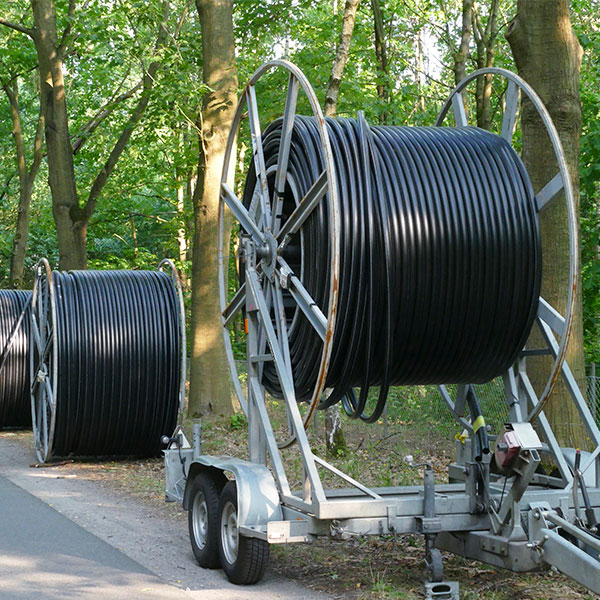

ARTICLE
Boost Broadband Connectivity with Free Space Optics
Why Free Space Optics (FSO) Should be Added to Your Broadband Deployment Toolkit
By Donna Yates | April 24, 2024
Read Time: 5 Minutes
The demand for increasingly faster connectivity continues to grow, and providers are working diligently to deploy new networks to meet those exploding needs.
While fiber is currently the preferred technology for internet delivery, there are often remote or challenging areas where it might not be feasible or economically prudent to deploy. That’s when using an alternative solution or a mixed model of technologies can help reduce the total cost of extending broadband coverage and accelerate the speed of deployment. The key is to identify and utilize the right technology in the right places.
Fiber, fixed wireless, and satellite are all playing an important role in connecting rural America, however, there are new emerging technologies that are particularly well-suited for bringing broadband to remote or challenging areas.
High-speed Internet by Laser
Yes, we said laser. While that sounds futuristic, it is quite simple. It is basically the same principle as an infrared remote controller for your TV and uses a technology called free space optics (FSO). Like fiber, FSO uses lasers to transmit data from one location to another, but instead of enclosing the data stream in a glass fiber, it is transmitted through the atmosphere to send and receive voice, video, and data communications.
Last Mile Connectivity Expansion
A FSO system can function over distances of several kilometers, as long as there is a clear line of sight between the source and the destination. With this capability, this type of laser internet technology is a viable alternative for ISPs and WISPs needing to rapidly expand last mile connectivity in their service regions and deliver broadband services with fiber-like performance.
Introducing Fiber-Like Last Mile Connectivity
Laser internet technology gives the industry another option to fiber optic cables, which as you know requires infrastructure-intensive physical cabling. Older FSO technology was much larger and heavier which made it hard to deploy. It also needed massive amounts of power to run. These are no longer concerns with the latest laser technology, which now delivers high-speed internet connectivity via a laser beam that eliminates the need for underground cabling or RF-based devices. With a sleek design that weighs less than 2.5kg per device, this new technology is not only compact, but can easily be deployed in just a few hours and it requires only 25-32W of power to run.
Some of the other features of this low-cost, high-bandwidth terrestrial communications device include:
- Ultra-high capacity – low latency 10 Gbps full duplex consistent data rate
- Easily installed in space-constrained locations
- Requires only 25 – 32W of power to operate, conducive to remote solar cell operation
- Automated pointing and tracking control (APT)
- Adaptive power control adjusts in real-time to changes in weather conditions
- Availability up to 99.999% depending on rain zone
- Active repeater technology (multi-hop) – signal strength is replicated across multiple hops, replicating what fiber extensions do without the need to physically install fiber
- Weather resilient wavelength
- Diffraction limited beams resulting in minimum spillover at the receiver
- Future proof, with the technology to scale as bandwidth needs grow
- Mobile and rapid deployment
Why Laser Technology Makes Sense
With the need for speed of deployment a primary consideration for many operators, there are multiple reasons as to why laser technology might be a perfect fit for your project:
- Can be readily deployed upon availability of line-of-sight - usually just a few hours for installation, configuration, and optimization
- No right-of-way required
- No spectrum licensing or permits
- No digging
- Highly secure and jam proof
- Eliminates the need for costly physical infrastructure and maintenance fees
- Easily moved and relocated for other uses

Unique and Powerful Tool to Address Connectivity Bottlenecks
Where connectivity gaps exist between two or more points, this type of technology is an effective and reliable solution that gives operators the advantage of faster time to market and the ability to quickly start generating revenue.
Beyond broadband deployments, there are many other uses for laser internet technology in enterprise applications. With the ease of deployment and size of this product that we’ve mentioned earlier, it is a perfect complementary solution in a wide variety of other applications, including:
- Campus networks – to improve inter-building connectivity in data centers, office parks, residential communities, shopping centers, and more
- Education – facilitates high-volume data flow within the grounds or buildings of a university, college, or school
- Mining and remote operations
- IoT applications
- Ports and logistics – enabling mission-critical applications for both port and terminal operations in RF congested environments
- Backup, dark fiber, or leased line alternative
- Defense – camps, forward deployments, or difficult terrain
- Quick disaster recovery efforts
- Urban – highly secure invisible laser communications between buildings, cell towers, and poles without the need for physical wires.
- Financial – highly secure, reliable, and fast connectivity
- Temporary events and festivals
Wireless laser communications fill a gap for customers who need an alternative to fixed-line infrastructure. Experience the future of wireless laser technology today, available through Wesco.

ABOUT THE AUTHOR
Donna Yates
Donna Yates is an experienced freelance writer with over 25 years of experience generating marketing strategies, programs, and collateral specifically focused on the Utility, Broadband, Global Service Providers, and Wireless markets.

